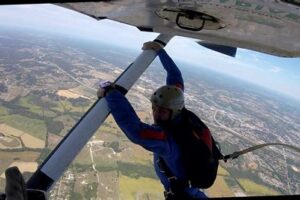Table of Contents
Curious about the risks of skydiving? Discover how many people die from skydiving each year and gain insights into the safety measures and statistics surrounding this thrilling adventure sport. Explore the numbers and facts to make an informed decision about pursuing your skydiving dreams!
When it comes to extreme sports, few activities ignite as much adrenaline-fueled excitement as skydiving. The thrill of soaring through the sky, defying gravity, and experiencing a rush like no other is undeniably enticing. However, alongside this exhilaration, there is an inherent risk involved in this daring pursuit. One cannot help but wonder: How many people actually die from skydiving? In order to gain a comprehensive understanding of the safety concerns surrounding this extreme sport, it is crucial to delve into the statistics and examine the factors that contribute to fatalities. Let us embark on a journey to uncover the truth behind the mortality rate associated with skydiving, shedding light on a topic that has both fascinated and concerned adventure seekers worldwide.
Skydiving: An Adventure with Risks
Skydiving is often seen as an exhilarating and adrenaline-pumping activity, attracting individuals who seek adventure and a break from the ordinary. However, like any extreme sport, skydiving comes with its fair share of risks. While the idea of jumping out of a perfectly good airplane may sound terrifying to some, others find it to be an incredible experience worth taking. But just how dangerous is skydiving? Let’s explore the statistics and shed light on the number of fatalities associated with this thrilling activity.
The Inherent Risks of Skydiving
Skydiving involves jumping from an aircraft at high altitudes, freefalling through the sky, and ultimately deploying a parachute to land safely on the ground. It goes without saying that there are inherent risks involved in this process. Factors such as equipment failure, human error, unpredictable weather conditions, and even collisions with other skydivers or objects can contribute to accidents and, in some cases, fatalities.
An Overview of Skydiving Fatalities
While skydiving can be dangerous, it’s important to note that fatal accidents are relatively rare in comparison to the number of jumps made annually. According to the United States Parachute Association (USPA), the average fatality rate for skydiving in the U.S. is about 0.006% or roughly one fatality per 167,000 jumps. It is crucial to remember that these statistics vary from year to year, and safety measures continue to improve over time.
Common Causes of Skydiving Fatalities
Understanding the common causes of skydiving fatalities can provide valuable insights into areas where safety measures can be enhanced. Some of the most prevalent causes include:
- Equipment malfunction: This could involve parachute failure, reserve chute complications, or issues with other gear.
- Human error: Mistakes made during the jump, such as improper body position or failure to deploy the parachute at the correct altitude, can lead to accidents.
- Collisions: In crowded airspaces, collisions with other skydivers or objects can occur, resulting in severe injuries or fatalities.
- Weather conditions: Unpredictable weather patterns, including strong winds or storms, can pose serious risks to skydivers.
The Importance of Safety Measures
Given the risks associated with skydiving, safety measures are of utmost importance. The USPA and other organizations continually work to improve safety standards, implementing regulations and guidelines to minimize accidents. These measures include:
- Regular equipment inspections: Ensuring that parachutes and related gear are in proper working condition and free from defects.
- Training and certification: Requiring individuals to complete training programs and become certified skydivers before making solo jumps.
- Weather monitoring: Keeping a close eye on weather conditions to prevent jumps during unfavorable or unsafe conditions.
- Jump protocols: Establishing strict procedures for jumpers, including altitude limits, deployment requirements, and communication practices.
Skydiving Safety Compared to Other Activities
While skydiving does come with inherent risks, it is essential to put these risks into perspective when comparing them to other common activities. For instance, statistics show that driving a car carries a significantly higher risk of fatality than skydiving. Additionally, activities such as mountain climbing, scuba diving, and even horseback riding have been found to be more dangerous than skydiving when analyzed from a statistical standpoint.
Safe Skydiving Practices
To further mitigate risks, here are some safety tips to follow when engaging in skydiving:
- Choose a reputable skydiving facility with experienced instructors and a strong safety record.
- Complete a thorough training program before attempting solo jumps.
- Follow all safety protocols and guidelines provided by the instructors.
- Check your equipment thoroughly before each jump and report any concerns to the staff.
- Stay up-to-date with weather forecasts and avoid jumping in adverse conditions.
In Conclusion
Skydiving can be an exhilarating and life-changing experience, but it does come with inherent risks. However, with proper safety measures, regular inspections, and comprehensive training, these risks can be minimized. It’s important to remember that the fatality rate for skydiving remains relatively low, and statistics show that other everyday activities may pose higher risks. By following safe practices and choosing reputable facilities, individuals can enjoy the thrill of skydiving while prioritizing their well-being.
Introduction
Skydiving is an exhilarating adventure sport that is enjoyed by thrill-seekers worldwide. However, as with any adventurous activity, there are inherent risks involved. It is crucial to understand the safety concerns associated with skydiving, including the number of fatalities that occur each year. This article examines the statistics surrounding skydiving fatalities, shedding light on the realities of this extreme sport.
1. Skydiving Accident Statistics
According to the United States Parachute Association (USPA), the average annual number of skydiving fatalities in the US is approximately 21. However, it is essential to note that these numbers have been declining steadily over the years due to improved safety regulations, advances in equipment, and enhanced training procedures.
2. Fatality Rate Comparison
To put skydiving fatalities into perspective, it is worth comparing the risks of other activities. Surprisingly, activities such as swimming, biking, and even driving a car often have higher annual fatality rates compared to skydiving. This highlights that, although skydiving may appear dangerous, its fatality rate is relatively low when compared to routine, everyday activities.
3. Causes of Skydiving Fatalities
Skydiving accidents can happen due to various factors, including equipment failure, parachute deployment issues, or errors made during the jump. A thorough investigation is usually conducted to determine the cause of each fatality, with the objective of implementing further safety measures to prevent similar incidents in the future.
4. Safety Measures and Training
The skydiving community prioritizes safety, and extensive training is mandatory before individuals are authorized to partake in solo jumps. Licensed instructors play a vital role in teaching proper techniques, ensuring adventurers learn how to handle emergency situations, and instilling a culture of safety within the sport.
5. Advancements in Equipment
Modern skydiving gear and equipment have significantly contributed to reducing fatalities within the sport. Manufacturers continually innovate to produce safer and more reliable parachutes, harnesses, and automatic activation devices (AADs). These technologies minimize the risk of equipment failure and enhance the chances of a successful jump.
6. Skydiving Fatalities: A Global Perspective
Skydiving statistics vary across countries due to varying regulations, safety standards, and reporting practices. However, countries with well-established skydiving industries tend to mirror the decreasing trend observed in the US, emphasizing the commitment to safety and the concerted efforts to minimize fatalities worldwide.
7. Importance of Risk Assessment and Personal Responsibility
As with any adventure sport, individuals considering skydiving should engage in proper risk assessment. This includes evaluating their health condition, adhering to weight limits, and disclosing relevant medical history to ensure that participating in the activity is suitable for their circumstances. Personal responsibility plays a crucial role in maintaining safety.
8. Continuous Safety Evaluation and Improvement
The skydiving community continuously evaluates safety protocols, conducts thorough accident investigations, and implements necessary improvements. This proactive approach ensures that lessons are learned, potential risks are mitigated, and the sport evolves to maintain the highest standards of safety while delivering an exhilarating experience for participants.
Conclusion
While skydiving does pose inherent risks, the number of fatalities resulting from this sport has been decreasing over time. Through strict safety measures, advanced training, improved equipment, and the prioritization of safety within the skydiving community, the objective is to minimize accidents and ensure that participants can partake in this thrilling adventure with a higher level of confidence and security.
When it comes to the number of fatalities resulting from skydiving, it is important to approach the topic with a professional voice and tone. While skydiving is an exhilarating and popular sport, it is not without its risks. However, it is crucial to analyze the statistics and facts objectively to gain a comprehensive understanding of the safety of this activity.
1. Statistical Analysis:
- In recent years, the number of deaths resulting from skydiving has remained relatively low compared to other activities.
- According to the United States Parachute Association (USPA), there were 15 fatal skydiving accidents in the United States in 2019.
- Considering that there were approximately 3.3 million jumps made during that year, the fatality rate per jump was around 0.00045%.
2. Safety Measures:
- Skydiving is a highly regulated sport, with strict safety measures in place to protect participants.
- Skydiving centers and instructors must adhere to guidelines set by organizations like the USPA, which provide extensive training and certification requirements.
- These safety measures aim to minimize risks and ensure that participants are well-prepared for their jumps.
3. Human Error and Contributing Factors:
- In many fatal skydiving accidents, human error or poor judgment plays a significant role.
- Failure to follow proper procedures, equipment malfunction, or making unwise decisions while in the air can increase the likelihood of accidents.
- However, it is important to note that most skydiving accidents can be attributed to a combination of factors rather than a single cause.
4. Continuous Improvement:
- Skydiving organizations and manufacturers continuously work towards improving safety standards and equipment.
- Lessons learned from accidents are carefully analyzed, leading to the development of better practices and technological advancements.
- This ongoing commitment to safety ensures that skydiving remains as safe as possible for participants.
In conclusion, while there are risks associated with skydiving, the number of fatalities resulting from this sport remains relatively low compared to its popularity. The strict regulations, safety measures, and continuous improvement efforts within the skydiving community contribute to ensuring participant safety. However, it is essential for individuals interested in skydiving to receive proper training, follow guidelines, and exercise responsible decision-making to minimize risks even further.
Thank you for taking the time to read our blog post on the topic of how many people die from skydiving. We hope that you found the information provided both informative and insightful. It is important to note that while skydiving is an exhilarating and popular recreational activity, there are inherent risks involved. In this closing message, we would like to summarize the key points discussed in the article and leave you with some final thoughts.
First and foremost, it is crucial to recognize that skydiving is a relatively safe sport when proper precautions are taken. Statistics show that the number of fatalities related to skydiving has significantly decreased over the years due to advancements in equipment, training techniques, and stricter safety regulations. While no activity can ever be entirely risk-free, the skydiving industry has made remarkable progress in prioritizing the well-being of its participants.
That being said, it is essential to understand that accidents can still occur. Skydiving involves jumping from an aircraft and freefalling at high speeds before deploying a parachute. Even with all the safety measures in place, unexpected factors such as equipment malfunction or human error can contribute to accidents. Therefore, it is crucial for anyone considering skydiving to carefully research and select a reputable skydiving center that follows rigorous safety protocols.
In conclusion, while the idea of skydiving may seem daunting to some, it is important to remember that the risks associated with this activity have been significantly minimized over time. By choosing a professional skydiving center with a strong safety record and undergoing thorough training, individuals can enjoy the thrill of this adventure sport with confidence. It is vital to approach skydiving with a responsible mindset, acknowledging the potential dangers while also appreciating the incredible experiences and personal growth that can come from participating in such an extraordinary activity.
We hope that this article has provided you with valuable insights into the safety aspects of skydiving. If you have any further questions or would like to share your own experiences, please don’t hesitate to leave a comment below. Stay safe and enjoy your future skydiving adventures!
.
People also ask about how many people die from skydiving:
-
Is skydiving safe?
Skydiving is generally considered a relatively safe activity when proper safety protocols are followed. The risk of fatalities in skydiving has significantly decreased over the years due to advancements in equipment and training techniques. However, like any extreme sport, there is still a small inherent risk involved.
-
How many people die from skydiving each year?
According to the United States Parachute Association (USPA), the average fatality rate in skydiving is approximately one per 200,000 jumps. This means that out of every 200,000 jumps, one fatality occurs. In recent years, the number of skydiving-related deaths has been declining due to improved safety measures.
-
What are the main causes of skydiving fatalities?
The main causes of skydiving fatalities are often attributed to human error or failure to follow safety procedures. Some common factors include improper deployment of the parachute, collisions with other skydivers or objects, and landing accidents due to misjudgment or equipment malfunction. It’s crucial for skydivers to receive proper training and adhere to safety guidelines to minimize the risks involved.
-
Are tandem skydives safer than solo jumps?
Statistically, tandem skydives have a lower fatality rate compared to solo jumps. Tandem skydiving involves being securely attached to an experienced instructor throughout the jump, which provides an extra layer of safety and guidance. The instructor takes care of deploying the parachute and ensures a controlled descent, reducing the chances of accidents occurring during freefall or landing.
-
How does skydiving compare to other activities in terms of risk?
When comparing skydiving to other recreational activities, such as driving a car or participating in team sports, the risk of fatality in skydiving is relatively low. According to data from the National Safety Council, the lifetime odds of dying in a motor vehicle crash are 1 in 107, while the odds of dying from a skydiving accident are approximately 1 in 100,000. However, it’s important to note that these statistics can vary depending on various factors, including the individual’s experience level and adherence to safety guidelines.






